The wheel is turning, indifferent to our applause and lament.
Month: October 2015
The Mago Way: Rediscovering Mago, the Great Goddess from East Asia (Review)
October 23, 2015When I began my own Goddess studies, I devoured the “Great Goddess,” “Gods and Goddesses of the World,” and “World Mythology” compilations that were available and noticed the complete absence of information about Korean goddesses. In some ways this is reflective of the nature of these anthologies, which attempt to move beyond Euro-centrism while avoiding the production of a huge, unwieldy, and costly volume. Paradoxically, this world overview approach creates or reinforces a chauvinism of its own. What becomes distilled for comparative study reflects the amount of material available. In the 1980s there didn’t seem to be anything in English for a casual reader about Korean goddesses. I can’t say that with authority, because finding Korean goddesses wasn’t exactly a mission of mine; only an absence that registered without my thinking too deeply about it. Helen Hye-Sook Hwang’s The Mago Way: Rediscovering Mago, the Great Goddess from East Asia, is a welcome and much-needed addition to Goddess studies that begins to fill this void.
Although The Mago Way mentions Korean goddesses, it is not about goddesses per se but about a Korean way of conceptualizing the Great Goddess. Except this conceptualization is not just Korean, but an understanding of Goddess cosmology that crosses national, ethnic, and geographic borders, using an ancient Korean manuscript as a foundational text. This manuscript, The Budoji, is an origin story believed to have been written in the 5th century.
The Budoji tells of the self-creation of the Great Goddess, called Mago, as a primordial sound emanating from a wave of light. Mago gives birth parthenogenically to daughters, two of them, who in turn each give birth to four daughters. Mago’s eight granddaughters create music attuned with Mago and move the “eight planets” in harmony with Mago’s vibration. The granddaughters are proto-humans, establishing four races. They in turn give birth to male and female humans, establishing the sexes.
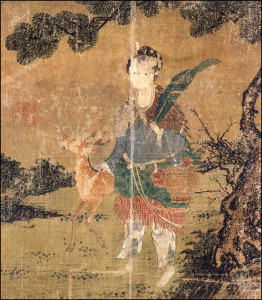
Hwang traces Mago through folktales, other goddesses, and place names throughout East Asia. She describes how Taoism, Buddhism, and Confusionism are derivative of the ancient Mago Goddess religion, shedding more light on these philosophies. She finds parallels with Magoism in the Greek Muses and Hindu Matrikas. She says “Mago’s affinity to other Goddesses becomes ever evident when we examine how the triad and parthenogenesis, the two paramount themes of the Magoist Myth, are in ancient gynocentric cultures and religions around the world.” Hwang demonstrates a strong background in radical feminist thealogy and shows how Mago fits within this framework.
The Mago Way is fairly short and readable, with illustrations. It is introductory, rather than comprehensive, and Hwang promises to go into the mythology in more depth in future volumes. I am not in any way qualified to assess Hwang’s scholarship; still, I sense this is an important book. I would not consider this volume esoteric or specialized in any way, but a valuable addition to overall Goddess studies.
Lions and Bees: What’s the Connection?
October 16, 2015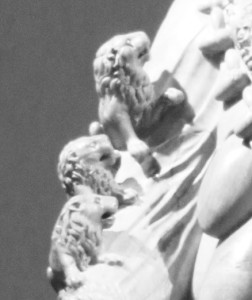
The following research is related to my next book (in progress) about animal divination.
Most people are aware of the connection between lions and bees through the biblical story of Samson. The hero featured in the Book of Judges was on his way to meet his betrothed when he encountered a lion, which he killed with his bare hands. Some days later he passed the carcass and found a swarm of bees in it, and he scraped out the honey and shared it with his parents without telling them where he found it. The biblical account is quite clear on this point, perhaps to reconcile some inconsistencies in the tale, such as that honey coming from a dead carcass would not have been kosher. A kernel of this story originates in the cult of the bee goddess of Anatolia, as does the myth of Aristaeus recounted by Virgil near the start of the Common Era. Before moving back to Anatolia, let’s look at the Greek myth.
Aristaeus was the child of the huntress Cyrene, who liked to wrestle lions barehanded, and the sun god Apollo. He was fostered by myrtle nymphs, who taught him the cottage industries of olive curing, cheesemaking, and beekeeping. One day he was distressed to find that all his bees were dead or dying. He traveled to a pool of water and asked his mother what to do. She directed him to a seer, who revealed this was punishment for his role in the death of Eurydice. (This occurs in a well-loved tale that is only tangential to this story.) Aristaeus sought his mother’s counsel again, and she instructed him to build four altars to the wood nymphs and on them sacrifice four bulls and four heifers. He was then to leave the sacrificial place and return on the morning of the ninth day, bringing poppies, a calf, and a black ewe. When Aristaeus returned with these offerings, he found bees in a rotting carcass, which rose in a swarm to a nearby tree.
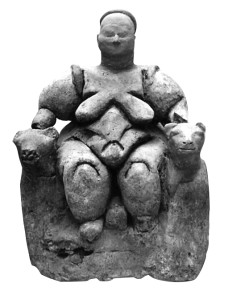
That Aristaeus is raised by myrtle nymphs is significant. It reveals him as a shamanic deity who travels to the underworld to gain knowledge. The myrtle tree is a symbol of love and marriage today due to its association with Aphrodite, who is remembered by most for her love goddess aspect, but myrtles in ancient Greece were used for funeral wreathes. While the flowers and even the leaves have a sweet fragrance, the sweetness was associated with death, perhaps because corpses emit a sweet odor as they decay. The idea of honeybees swarming on a dead carcass of any kind is absurd, although they do gather around the myrtle tree.
Bee and lion imagery in Anatolia goes back to before the fifth millennium. The Seated Woman of Catal Huyuk, who is flanked by two felines usually identified as leopards (which could as easily be lionesses), looks strikingly similar to classical statues of Cybele. The goddess Cybele is unmistakably enthroned between male lions.
Cybele’s myth, as told by the Greeks, starts with her arrival from outer space in the form of a meteorite. Cybele eventually falls in love with the beautiful god Attis, who returns her attentions for a time, then becomes infatuated with another. The infuriated Cybele harasses him ceaselessly until he goes insane. In remorse, Attis tears off his genitals and dies of his wounds beneath a pine tree. Cybele tearfully shrouds his body and buries it at the mouth of her sacred cave shrine, along with the transplanted pine tree.
Perhaps it was Cybele’s fiery form across the sky that first evoked the image of the fierce, fleet, destructive lion. The tormenting Cybele is the angry bee. The emasculation of Attis refers to the death of the drone after copulation. The pine is of a species found in Turkey which draws a type of aphid that sweats a sweet nectar. Bees congregate around this pine, attracted to the aphid nectar. The resulting honey is renowned for both its taste and its healing properties, and it is mentioned in Classical medical literature.
Another healing agent known to ancient physicians is the opium poppy, which strongly attracts bees. The bees gather poppy pollen granules to take back to the hive. Bees, lions, and flowers that could be poppies appear on the statue of Artemis of Ephesus, along with cattle, goats, and the animals of the zodiac. Whatever the name and personality of the mother-goddess as she was first worshiped at Ephesus, she evolved into a goddess exhibiting hybrid traits of Cybele and of Artemis, who had already absorbed many other goddesses by the time the Greeks colonized the Anatolian coast. That the bee is meant to be a significant and not a minor facet of Ephesian Artemis is demonstrated by the coinage of the city-state: deer on one side; bee on the other.
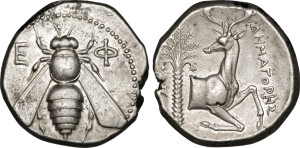
It is in Greece that art specifically linking the bee and the lion first appears, yet the association seems to have been imported from Anatolia. The swarm of bees arising from the heifer/bull sacrifice rather than from a lion is a Greek permutation of another myth. Normally bees are assumed to be linked exclusively with bulls in pictures, but we often forget cows can also have horns. Bees and cows are alike from a human standpoint, in that they provide nourishing food from their bodies. Bees like cows are normally fairly docile and allow themselves to be “herded” into a new field or nest site. But bees are like lions in that they roar, they like the sun, they hunt in an open field, they are territorial, they attack in a coordinated fashion, and (when possible) they make their home in caves.
Sources
Gough, Andrew. “The Bee” (parts I-II-III). June 2008. http://andrewgough.co.uk/articles_bee1/
Graves, Robert. The Greek Myths. London: Penguin, 1992.
Monaghan, Patricia. The Book of Goddesses and Heroines. St Paul, MN: LLewellyn, 1990.
New English Bible. New York: Cambridge University Press, 1972.
Nap Time’s Over: Mercury Goes Direct
October 9, 2015Mercury retrograde (when the planet Mercury appears to be moving backward in the sky from our Earth perspective) is a time for taking care of things we’ve been neglecting. Often that thing that’s been neglected is sleep. Mercury goes direct October 9th at 10:57 am Eastern Time (14:57 Universal Time), so it’s time for things to start moving forward again. What a relief!
Thoughts on Sunday’s Eclipse
October 2, 2015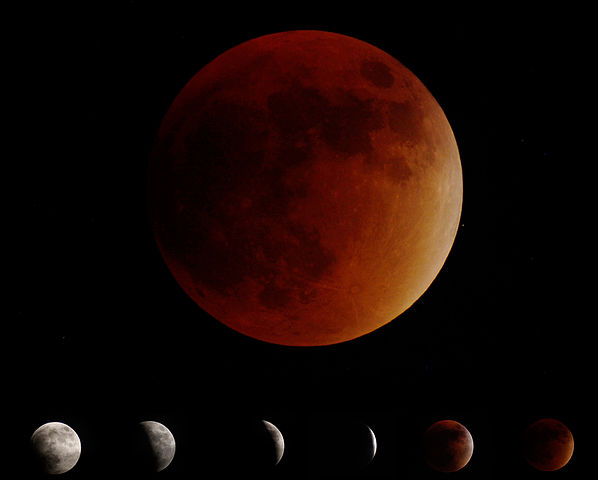
This week was my first opportunity, believe it or not, to view a total lunar eclipse. Times when I might have theoretically been able to witness the event, the sky has been overcast. I watched the eclipse from the parking area in back of my house, a rather unromantic spot to commemorate a great occurence but one that afforded clear unimpeded observation. I had to stay up rather late to be visually present, but I was still very alert, and I can corroborate that the moon at first seemed to disappear bite by bite, and then to be present in a greatly diminished state. At first I was incredulous, despite intellectually understanding and accepting the event, as the immediate impact was surreal.
Of course I have been present for every partial and total eclipse in my lifetime, whatever the time of day or atmospheric condition. Without access to a spaceship there is no other choice. I think this eclipse has been unusually impactful, and I mean that in an uncomfortable karma-as-teacher kind of way. A lot of unbalanced accusations flying, with less self-aware people reacting to internal conflicts in a projected manner. I don’t know whether this heightened eclipse syndrome is related to this being a supermoon (moon at its closest orbit to earth), the eclipse occurring so close to the equinox, or Mercury retrograde adding communication problems to an already difficult aspect. Usually I do not do any magic around the time of an eclipse. I find the spell dampened or ineffective and prefer to wait for a more productive time. Beginning a day or two before the solar eclipse and continuing until the lunar, I try to affect my will magically as little as possible. Sometimes other events make this policy impractical, such as the Fall Equinox/Harvest holiday occurring smack in the middle of the two events. Even in this situation, however, I tend to keep the focus on worship rather than tangible goals. I have been taking a vacation even from larger writing projects and spending more time in the woods. I had to come out of retreat temporarily last week nonetheless to use magic to aid someone in a crisis that needed immediate intervention.
For me the eclipse seemed to be winding down even as it began, since I am an Aries and we tend to experience transits before they happen. I think this has to do with the Aries attraction to novelty manifesting as recognition of new vibrations in their prodromal phase, giving way to boredom with them as they develop. In fact, I’m surprised I’m even interested in debriefing this recent astrological event. It was, however, an exceedingly powerful one.



